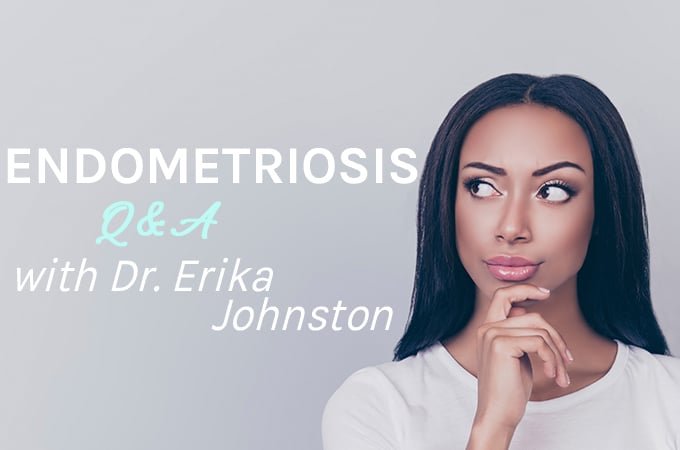

What is Endometriosis?
Endometriosis is a condition in which the endometrial tissue, which should line the inside of the uterus, grows on the outside of the uterus – sometimes causing infertility. Endometriosis presents itself in many ways, some women have chronic pelvic pain, some experience infertility, and others may have no symptoms and the diagnosis is an incidental finding at the time of another unrelated surgery.
Due to the varied nature in which the disease is experienced, the actual percentage of women who have endometriosis has been very difficult to determine. Estimates range from 6-10% of reproductive-aged females, though these rates are higher in populations with infertility or pelvic pain.
Birth control pills and other medications can be used to reduce the symptoms of endometriosis. For those experiencing infertility due to the disease, there are fertility treatments available to help you conceive.
Causes and Symptoms of Endometriosis
Endometriosis results from one common underlying cause – when the normal tissue that forms the lining of the inside of the uterus (the “endometrium” – the part that is shed during a period) is present anywhere in the body outside of the uterus. Multiple theories exist about how this occurs in the first place, though passage of the menstrual fluid through the fallopian tubes into the abdominal cavity is the most commonly suspected cause.
The subsequent symptoms that develop are the result of this abnormally located endometrium. Envision the cramps and discomfort experienced in the uterus during a period, and apply that to the other organs in the abdomen on a larger scale to get a sense of the pain some women experience. Conversely, the disease may be present with no symptoms at all because it doesn’t affect any of the nerve endings that would activate pain signals. In these cases, disease may manifest as infertility related to inflammation or distorted anatomy of the fallopian tubes or ovaries, or even no problems at all.
Diagnosing Endometriosis
Endometriosis can only be diagnosed by surgery, with sampling of abnormal lesions and confirmation by a pathologist’s microscopic evaluation. Certain testing can be highly suggestive of endometriosis, such as an ultrasound showing a visible endometriosis cyst on the ovary, but nothing short of surgery can absolutely confirm it. Complicating the issue is that there are many causes of pelvic pain and infertility unrelated to endometriosis, so performing surgery anytime these issues arise would result in a very large volume of unnecessary surgery.
Treating Endometriosis
Because the tissue that forms the lining of the uterus only functions in women with active ovarian hormone production, endometriosis is almost exclusively confined to reproductive-aged women, generally excluding those prior to puberty and after menopause. Fortunately, this provides an avenue for treatment of endometriosis. Birth control pills and a variety of other medications can be used to regulate hormone production, thus reducing the symptoms experienced.
The Staging System of Endometriosis
You may have heard of the staging system used to classify endometriosis, which was developed by the American Society of Reproductive Medicine (ASRM). The staging system breaks endometriosis into four categories:
- Stage I – minimal disease
- Stage II – mild disease
- Stage III – moderate disease
- Stage IV – severe disease
This staging system allows more uniform reporting of the extent of the disease present in the pelvis at the time of surgery, but significant limitations exist. One limitation is the poor correlation between the degree of pain experience and the stage of disease – a woman with Stage I disease could potentially be far more symptomatic than a woman with Stage IV disease. There is also poor correlation between the stages of the disease and infertility or pregnancy rates after surgical treatment.
Surgery is generally elected when a patient has significant pain symptoms that have not responded to more conservative medical therapies. In patients with pelvic pain and confirmed endometriosis, surgery decreases symptoms in 80% of patient for up to six months, though over a third of patients will require additional surgery within three years for recurrent symptoms.
In the circumstance of infertility, surgery is reserved for very specific situations. Why? It takes twelve surgeries on a woman with confirmed minimal to mild disease to achieve one additional live birth. The difficulty is that generous estimates are one in four women with suspected endometriosis actually have the disease. That means nearly 50 women would need surgery (not a risk-free event) to result in one baby being born!
In cases of moderate to severe endometriosis, it may be reasonable to consider surgery prior to fertility treatment. This is typically decided on a case-by-case basis. It is a fine balance between improving pregnancy rates by removing disease and surgically depleting ovarian function (some normal tissue will be removed when endometriosis is cut from the ovary). Fortunately, alternative infertility treatments exist that can compensate for the problems caused by endometriosis, even when it is present on the ovaries.
If you have been diagnosed with or suspect endometriosis and would like to learn more about your family building options, please schedule an appointment, or speak with one of our New Patient Liaisons at 877-971-7755.





